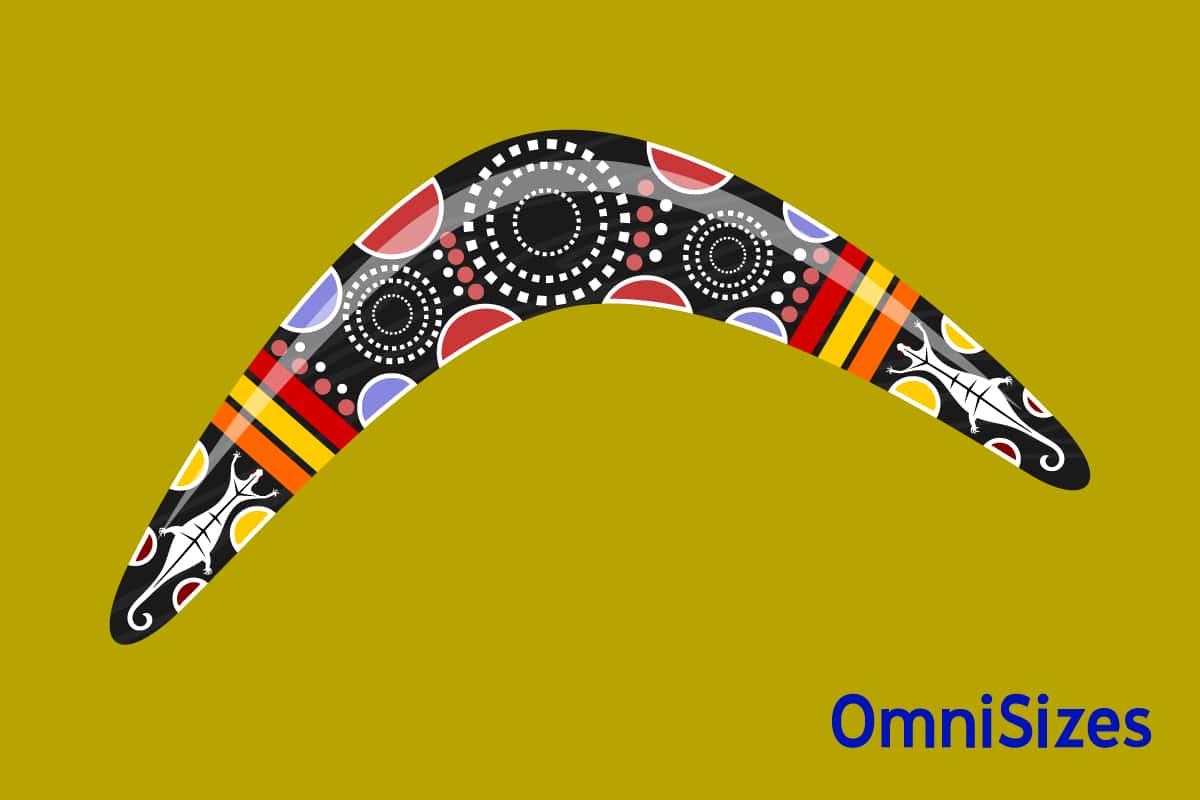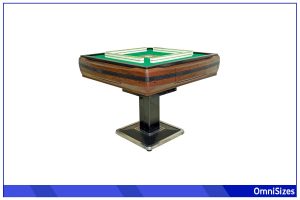Boomerangs, the iconic curved throwing tools, have fascinated people worldwide for centuries. Boomerang sizes greatly influence their flight pattern and usability. Originating from indigenous Australian cultures, these tools have evolved from hunting and ceremonial instruments to modern sports and recreational items.
Common boomerang sizes range from 8 to 24 inches (20.3 to 61 cm) for sport-focused designs, to larger, traditional ones measuring up to 36 inches (91.4 cm). These measurements refer to the distance between both ends, including the curved elbow.
Today’s guide will go over the basics of boomerang size based on type, boomerang material makeup and weight, and how to choose the appropriate size for throwing.
Basic Boomerang Types and Their Sizes
Boomerangs are marvels of aerodynamics, each type designed for a specific purpose. Their sizes influence their flight and function.
Traditional Aboriginal Boomerangs
Aboriginal boomerangs, known for their rich cultural heritage, typically measure between 11.8 to 23.6 inches (30 to 20 cm) in length. Their sizes reflect their uses, from hunting to ceremonial purposes.
Smaller boomerangs, around 24 inches (61 cm), are swift and used for hunting small game, while larger ones, up to 36 inches (91.4 cm), designed for ceremonies, showcase intricate art and designs.
Modern Sport Boomerangs
Sport boomerangs, a modern twist on the traditional design, are usually smaller, ranging from 8 to 24 inches (20.3 to 61 cm). They are specifically crafted for precision and speed in boomerang competitions.
The size of these boomerangs determine the desired flight patterns, with smaller sizes offering tighter turns and larger ones providing longer flight durations. Beginners often start with a medium-sized, 9-inch (22.8 cm) boomerang, which offers a balance between control and distance.
Decorative Boomerangs
Decorative boomerangs, while not designed for throwing, are significant for their artistic value. These boomerangs can vary greatly in size, from small 6-inch (15.2 cm) pieces suitable for display shelves to large, 1-meter (3.2 feet) wall pieces that make a statement.
The size often corresponds with the complexity of the artwork and the story it tells. Collectors and enthusiasts value these for their craftsmanship and cultural representation.
Size Considerations for Different Uses
The boomerang’s dimensions are tailored to maximize efficiency and effectiveness in its intended use.
Sporting Boomerangs
Sporting boomerangs are designed for precision and agility, typically measuring between 8 to 12 inches (20.3 to 30.5 cm). Their smaller size allows for tighter turns and quicker returns, essential in competitions. The weight distribution in these boomerangs is finely tuned, ensuring they can perform complex flight patterns.
Hunting Boomerangs
Traditional hunting boomerangs are larger, usually between 24 to 36 inches (61 to 91.4 cm). These are not designed to return but to travel long distances in a straight line. The larger size and heavier weight aid in maintaining a stable flight over longer distances for hunting small game.
Recreational Boomerangs
Recreational boomerangs, popular in parks and open spaces, vary widely in size, typically ranging from 8 to 16 inches (20.3 to 40.6 cm). They strike a balance between ease of use and the thrill of a returning flight. Smaller, lightweight recreational boomerangs are preferred for casual throwing, as they require less space and skill.
Boomerang Materials and Weight
The material used to make a boomerang affects it weight, flight pattern, and usage.
Traditional Wooden Boomerangs
Wooden boomerangs are the most traditional and widely recognized. Crafted from woods like Birch, Oak, or the Australian Mulga, these boomerangs carry the legacy of their origins. Their weight varies, with smaller ones weighing around 100 to 200 grams, and larger, more ornate ones can weigh up to 500 grams.
Plastic and Composite Boomerangs
Plastic and composite materials have revolutionized boomerang design. These materials allow for precise weight distribution, essential for competitive boomerang sports. Lightweight plastics are used for smaller, trick boomerangs, often weighing between 50 to 150 grams. Composites like carbon fiber and fiberglass are used for professional-grade boomerangs, offering an ideal balance between weight and durability.
Plywood Boomerangs
Plywood, a versatile and accessible material, is popular among hobbyists and professionals. Plywood boomerangs are usually mid-weight, ranging from 150 to 300 grams. The layered construction of plywood allows for strength and flexibility.
Foam and Rubber Boomerangs
Foam and rubber boomerangs represent the safest options, especially for children and indoor use. These boomerangs are the lightest, generally weighing under 100 grams. Their soft, lightweight nature makes them ideal for beginners, reducing the risk of injury and damage.
Tips for Throwing a Boomerang
Follow these tips to throw your boomerang successfully for the fit time!
Choosing the Right Boomerang
The first step is selecting a boomerang suitable for your skill level and intended use. Beginners should opt for medium-sized, lightweight boomerangs, which are easier to throw and catch.
Grip and Stance
A proper grip is crucial for a successful throw. Hold the boomerang vertically, with your thumb and forefinger at the top end of one wing. Your stance should be relaxed, with feet shoulder-width apart. Align your body with the direction of the wind, as this plays a significant role in the boomerang’s flight.
Throwing Techniques
- For Beginners: Start with a gentle, straightforward throw. Tilt the boomerang at a slight angle away from your body, and use a smooth wrist action to release it. Aim to throw at a 45-degree angle into the wind for a consistent return path.
- Advanced Techniques: As you gain proficiency, experiment with different throwing angles and speeds. Adjust the tilt and rotation for longer flights or trickier returns. Advanced throwers can try varying wind conditions and more complex boomerangs.
Catching the Boomerang
Catching a returning boomerang requires timing and hand-eye coordination. Watch the boomerang’s flight and prepare to catch it as it slows down and hovers. Extend your hands, forming a clap, and catch the boomerang between your palms.
Safety Precautions
- Always throw in an open area, away from people, animals, and obstacles.
- Use safety glasses to protect your eyes.
- Be aware of the wind direction and strength, as it greatly affects the boomerang’s flight.
- Never throw a boomerang in strong winds, as it can become unpredictable.






